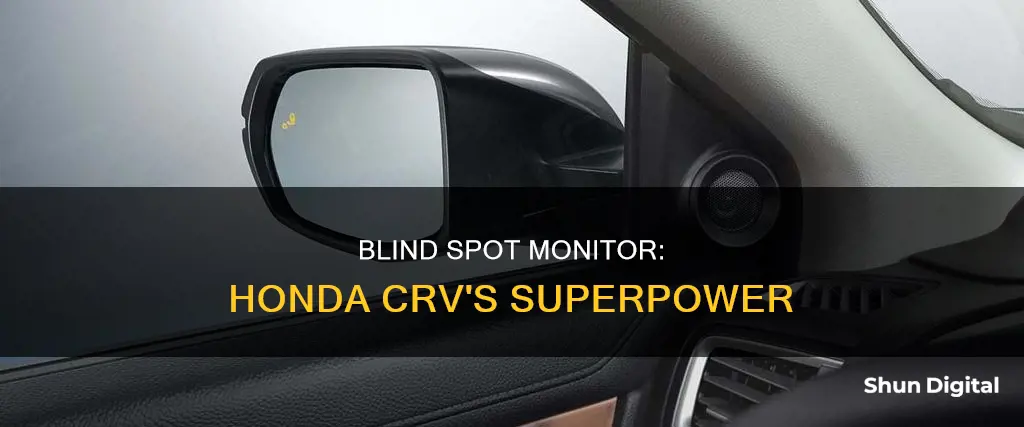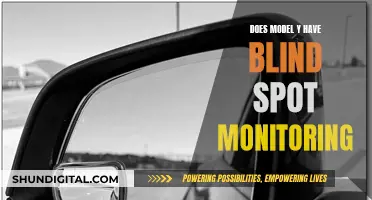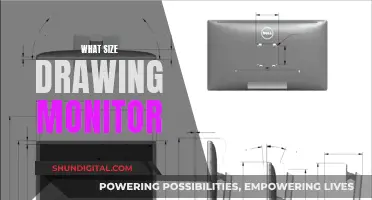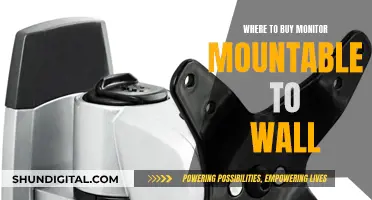
Blind-spot monitoring is an important safety feature in modern cars that helps drivers avoid collisions when changing lanes or merging into traffic. Honda has integrated blind-spot monitoring into many of its current models, including the popular Honda CR-V compact SUV. The CR-V's Blind Spot Information System™ uses sensors to detect vehicles in the driver's blind spots and alerts them through a warning light or sound. This feature is designed to enhance the driver's confidence and safety, especially when navigating busy city streets or highways. While the system provides valuable assistance, drivers are still responsible for visually assessing their surroundings and safely operating their vehicles.
What You'll Learn

How does the blind spot monitor work?
The Honda CR-V's Blind Spot Information System (BSI) is designed to give the driver additional information about the conditions around the vehicle to enhance driving confidence and safety. The system uses a pair of sensors, one on each rear corner of the vehicle, to detect vehicles in adjacent lanes. When the vehicle is moving forward at 20 mph or above and the system detects an object in the blind spot, an indicator located in each of the side mirrors alerts the driver. If the BSI detects an object when the turn signal is on in that direction, the indicator flashes and an alert sounds to catch the driver's attention.
The alert zones on each side initially extend from about 1.6 to 10 feet from the sides of the vehicle and about 10 feet past the rear bumper. As the vehicle is driven more on straight roads with traffic and roadside objects, the system will adapt and extend the alert zone about another 82 feet back. The faster vehicles are travelling in the extended zones, the farther away they will be detected.
It is important to note that the Blind Spot Information System is not a substitute for the driver's own visual assessment before changing lanes. The system may not detect all objects behind or to the side of the vehicle, and its accuracy will vary based on weather conditions, object size, and speed. The driver remains responsible for safely operating the vehicle and avoiding collisions.
The Honda CR-V's BSI provides valuable assistance to the driver by monitoring blind spots and alerting the driver to potential hazards. By using sensors and alerts, the system enhances the driver's awareness of their surroundings and helps them make more informed decisions when changing lanes or merging into traffic.
Overall, the Blind Spot Information System in the Honda CR-V is a useful feature that improves safety and driving confidence. It helps drivers by providing additional information about their surroundings and alerting them to potential hazards, allowing them to make better decisions and avoid collisions.
Diagnosing Monitor: Inconsistent Frequency, What to Look For
You may want to see also

What are the benefits of the system?
The Blind Spot Information System (BSI) in the Honda CR-V is designed with one goal in mind: to keep the driver and passengers as safe as possible. The system provides drivers with additional information about conditions around the vehicle, enhancing driving confidence and overall safety.
The BSI in the CR-V uses sensors to detect vehicles in the driver's blind spots, providing an extra layer of safety when changing lanes or merging into traffic. This is especially useful on busy roads or highways where traffic is constantly changing and unpredictable. The system alerts the driver with a warning light or sound, catching their attention and helping to avoid potential collisions.
The CR-V's BSI has a dynamic alert zone that adjusts based on driving conditions. When driven more frequently on straight roads with traffic and roadside objects, the system extends the alert zone further back, providing even more advanced warning of potential hazards. This adaptability ensures that drivers are not overwhelmed with alerts in busy areas but still receive timely warnings when necessary.
The BSI is not a substitute for the driver's own visual assessment before changing lanes, and drivers remain responsible for safely operating the vehicle and avoiding collisions. However, the system provides valuable assistance and peace of mind, helping to mitigate potential blind spots and enhancing overall awareness of the vehicle's surroundings.
The benefits of the BSI in the Honda CR-V include increased safety, improved driver confidence, and a more relaxed driving experience, especially in busy or congested areas. The system's adaptability and dynamic alert zones further enhance its effectiveness, providing drivers with a valuable tool to assist in making informed decisions and reducing the risk of accidents.
Monitor Overclocking: Stability Testing for Beginners
You may want to see also

When does the system activate?
The Blind Spot Information System (BSI) in the Honda CR-V is designed to activate when the vehicle is moving forward at a speed of 20 mph or above. It uses sensors on the rear corners of the vehicle to detect any vehicles in adjacent lanes that may be in the driver's blind spot. When the system detects an object in the blind spot, it alerts the driver through an indicator in the side mirrors. If the turn signal is on in the direction of the detected object, the indicator flashes and an alert sounds to draw the driver's attention.
The alert zones for the BSI initially extend from 1.6 to 10 feet from the sides of the vehicle and about 10 feet past the rear bumper. As the vehicle is driven more frequently on straight roads with traffic and roadside objects, the system adapts and extends the alert zone by another 82 feet back. The system also takes into account the speed of other vehicles in the extended zones, detecting them from a farther distance when they are travelling at higher speeds.
It is important to note that the BSI is not a substitute for the driver's own visual assessment before changing lanes. The system may not detect all objects, and its accuracy can vary based on weather conditions, object size, and speed. The driver remains responsible for safely operating the vehicle and avoiding collisions.
In terms of availability, the BSI is standard on CR-V EX and above trims, enhancing driving confidence by providing additional information about the conditions around the vehicle.
Simple Ways to Identify Your Monitor's 2K Resolution
You may want to see also

What happens if the blind spot monitor fails to detect an object?
The blind spot monitoring system in the Honda CR-V is an important safety feature that helps drivers avoid collisions when changing lanes or merging into traffic. While this system is designed to provide valuable assistance, it is not perfect and can fail to detect objects in certain situations. So, what happens if the blind spot monitor fails to detect an object?
Firstly, it's important to understand the limitations of blind spot monitoring systems. They are designed to detect vehicles within a certain range, typically those that are directly alongside or a few car lengths back. Objects outside of this range, such as vehicles approaching from the opposite direction or directly from behind, may not trigger a warning. Additionally, the system may not always detect smaller objects like motorcycles or stationary objects like guard rails or poles.
In the event that the blind spot monitor fails to detect an object, the driver will not receive any alerts or warnings. This means that the driver may be unaware of the potential hazard and could make a lane change or merging manoeuvre that results in a collision. It is important for drivers to understand that blind spot monitoring systems are not a substitute for proper mirror checks and visually scanning the surrounding area before making any lane changes.
There are several reasons why a blind spot monitor may fail to detect an object. One common issue is related to speed. Some systems have speed limitations and will only become active once the vehicle reaches a certain speed, typically around 20 miles per hour. If the car is travelling at a very low speed, the system may not detect surrounding vehicles.
Another factor that can affect the performance of the blind spot monitor is the cleanliness of the sensors and cameras. If the sensors in the rear bumper or the camera lenses in the side-view mirrors are obstructed by dirt, snow, ice, mud, or condensation, the system may not function correctly. Therefore, it is important to regularly clean these components to ensure optimal performance.
In some cases, the blind spot monitoring system may simply malfunction due to technical issues or wiring problems. The system may stop working randomly, fail to illuminate the warning light, or provide incorrect information about the location of objects. These types of issues usually require professional assistance to diagnose and repair.
While blind spot monitoring systems can be incredibly helpful, drivers should not solely rely on them for safety. It is important to maintain good driving habits, such as regularly checking mirrors, using turn signals, and looking over your shoulder when changing lanes. By combining safe driving practices with the assistance of advanced technologies like blind spot monitoring, drivers can enhance their overall safety on the road.
Monitoring Employee Emails: Ethical or Not?
You may want to see also

How does the blind spot monitor affect resale value?
Blind spot monitoring (BSM) is an important safety feature in modern cars that helps drivers avoid collisions when changing lanes or merging into traffic. The system uses sensors, typically radar or ultrasonic, to detect vehicles in the blind spots and alerts the driver with a warning light or sound. This feature can be especially useful for the Honda CR-V, a compact SUV, as it can provide the driver with a clear view of the vehicle's surroundings and help avoid collisions when backing up or changing lanes.
When it comes to resale value, having a blind spot monitor can be a significant advantage. Prospective buyers often look for advanced safety features, and a well-functioning BSM can be an attractive selling point. It demonstrates that the vehicle is equipped with modern safety technologies, which can justify a higher asking price and make the vehicle more appealing on the used car market. This is especially true if the BSM is integrated with other safety features such as lane departure warning or rear cross-traffic alert, creating a comprehensive safety package.
The effectiveness of BSM in enhancing driving safety is supported by statistics. According to the Insurance Institute for Highway Safety (IIHS), blind-spot monitoring reduces lane-changing accidents by 14% and injuries from such crashes by 23%. This data highlights the value that a BSM can add to a vehicle, making it a desirable feature for buyers.
Additionally, the integration of BSM with other vehicle systems can further enhance its impact on resale value. For example, some Honda models pair the BSM with a rearview camera and dynamic guidelines, providing an even clearer view of the vehicle's surroundings. This level of integration and the resulting improvement in safety can positively influence the resale value.
However, it is important to note that the impact of BSM on resale value may vary depending on the specific vehicle model, the age of the vehicle, and the preferences of potential buyers. While BSM is becoming increasingly standard across vehicle models, including in the Honda CR-V, it is still an optional feature in some cases. As such, the presence of BSM can be a differentiating factor for buyers, potentially increasing the resale value for vehicles that offer this feature.
Simple Ways to Check Your Monitor's Refresh Rate
You may want to see also
Frequently asked questions
The Blind Spot Information System (BSI) in the Honda CR-V is a safety feature that uses sensors to detect vehicles in the driver's blind spots and alerts the driver with a warning light or sound.
The system uses a pair of sensors, one on each rear corner of the vehicle, to detect vehicles in adjacent lanes. An indicator in each side mirror then alerts the driver. If an object is detected when the turn signal is on, the indicator flashes and an alert sounds.
The blind spot monitor activates when the vehicle is moving forward at about 20 mph or above.
The blind spot monitor enhances driving confidence by providing additional information about conditions around the vehicle. It helps drivers avoid collisions when changing lanes or merging into traffic, especially on busy roads or highways.
The blind spot monitor is standard on CR-V EX and above trims. However, there may be variations in availability depending on the model year and specific market or region.







